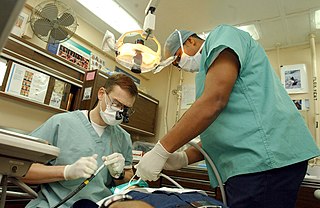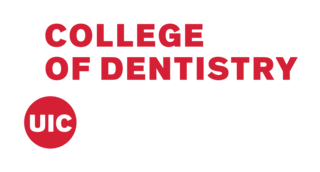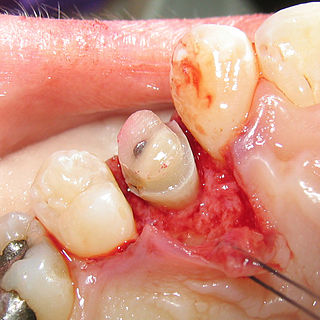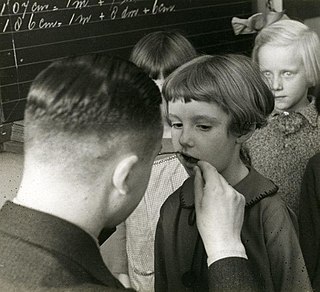
Dentistry, also known as dental medicine and oral medicine, is the branch of medicine focused on the teeth, gums, and mouth. It consists of the study, diagnosis, prevention, management, and treatment of diseases, disorders, and conditions of the mouth, most commonly focused on dentition as well as the oral mucosa. Dentistry may also encompass other aspects of the craniofacial complex including the temporomandibular joint. The practitioner is called a dentist.

A dentist, also known as a dental surgeon, is a health care professional who specializes in dentistry, the branch of medicine focused on the teeth, gums, and mouth. The dentist's supporting team aids in providing oral health services. The dental team includes dental assistants, dental hygienists, dental technicians, and sometimes dental therapists.
Prosthodontics, also known as dental prosthetics or prosthetic dentistry, is the area of dentistry that focuses on dental prostheses. It is one of 12 dental specialties recognized by the American Dental Association (ADA), Royal College of Surgeons of England, Royal College of Surgeons of Edinburgh, Royal College of Surgeons of Ireland, Royal College of Surgeons of Glasgow, Royal College of Dentists of Canada, and Royal Australasian College of Dental Surgeons. The ADA defines it as "the dental specialty pertaining to the diagnosis, treatment planning, rehabilitation and maintenance of the oral function, comfort, appearance and health of patients with clinical conditions associated with missing or deficient teeth or oral and maxillofacial tissues using biocompatible substitutes."
A number of professional degrees in dentistry are offered by dental schools in various countries around the world.

The UCLA School of Dentistry is the dental school of the University of California, Los Angeles (UCLA) located in the Center for Health Sciences building in the Westwood neighborhood of Los Angeles, California, United States. The school has several educational and training programs, conducts oral and dental health research, and offers affordable dental care at three locations: Westwood, Venice, and Inglewood. The school also participates in several outreach endeavors, including numerous health fairs during the year, STEM pipeline programs and provides dental care for underserved populations in the region. The School of Dentistry is considered among the nation's best research-intensive dental schools.
The University of Pittsburgh School of Dental Medicine is the dental school of the University of Pittsburgh (Pitt). It is located in Pittsburgh, Pennsylvania, United States. It is one of Pitt's six schools of the health sciences and one of several dental schools in Pennsylvania. It is closely affiliated with the University of Pittsburgh Medical Center. The School of Dental Medicine accepted 3.6% of applicants for the class of 2016, a record low for the school's entire history.

The University of Illinois at Chicago College of Dentistry evolved from the Columbian Dental College, founded in Chicago in 1891.
The following outline is provided as an overview of and topical guide to dentistry and oral health:

Crown lengthening is a surgical procedure performed by a dentist, or more frequently a periodontist, where more tooth is exposed by removing some of the gingival margin (gum) and supporting bone. Crown lengthening can also be achieved orthodontically by extruding the tooth.
A dental school is a tertiary educational institution—or part of such an institution—that teaches dental medicine to prospective dentists and potentially other dental auxiliaries. Dental school graduates receive a degree in Dentistry, Dental Surgery, or Dental Medicine, which, depending upon the jurisdiction, might be a bachelor's degree, master's degree, a professional degree, or a doctorate. Schools can also offer postgraduate training in general dentistry, and/or training in endodontics, oral and maxillofacial surgery, oral pathology, oral and maxillofacial radiology, orthodontics, pedodontics, periodontics, prosthodontics, dental public health, restorative dentistry, as well as postgraduate training for dental hygienists and dental technicians.
Dental pertains to the teeth, including dentistry. Topics related to the dentistry, the human mouth and teeth include:
Special needs dentistry, also known as special care dentistry, is a dental specialty that deals with the oral health problems of geriatric patients, patients with intellectual disabilities, and patients with other medical, physical, or psychiatric issues.

Pediatric dentistry is the branch of dentistry dealing with children from birth through adolescence. The specialty of pediatric dentistry is recognized by the American Dental Association, Royal College of Dentists of Canada, and Royal Australasian College of Dental Surgeons.
The University of Iowa College of Dentistry is the dental school of the University of Iowa. It is located in Iowa City, Iowa, United States. It is the only dental school in Iowa and is one of only two dental colleges in the United States to offer all the American Dental Association (ADA) accredited dental specialty training programs. It is consistently rated as a top dental school in the country with strong clinical training and research exposure for dental students. Several Iowa alumni serve in leadership positions in academics and in organized dentistry.
The University of Kentucky College of Dentistry (UKCD) is the dental school of the University of Kentucky. It is located in the city of Lexington, Kentucky, United States. It is one of two dental schools in Kentucky.
In the United States and Canada, there are twelve recognized dental specialties in which some dentists choose to train and practice, in addition to or instead of general dentistry. In the United Kingdom and Australia, there are thirteen.

Manipal College of Dental Sciences, Mangalore was founded in 1987 and recognised by the Dental Council of India in 1992 and by the Malaysian Dental Council in 2003. It was certified for ISO9001:2000 in 2006 and was re-certified for ISO9001:2008 in 2009. The college is a part of Manipal University. The college offers undergraduate (BDS) and postgraduate (MDS) programme.

Dublin Dental University Hospital is a dental health and teaching facility at Lincoln Place, Dublin, Ireland. The Dublin Dental University Hospital is located on the Trinity College Dublin campus. It is the predominant teaching hospital for dentistry in Ireland, where undergraduate and graduate dental students, dental nursing students, dental technicians, and dental hygienists are all educated. Trinity College Dublin's Dental School resides at Dublin Dental University Hospital.







